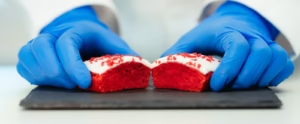Saturday, 17 January 2026
Fast food associated with higher levels of Phthalates
Eating out more at eateries, cafeterias and fast-food outlets may boost add up to levels of possibly health-harming chemicals called phthalates in the body, concurring to a think about out today. Phthalates, a gather of chemicals utilized in nourishment bundling and preparing materials, are known to disturb hormones in people and are connected to a…

Eating out more at eateries, cafeterias and fast-food outlets may boost add up to levels of possibly health-harming chemicals called phthalates in the body, concurring to a think about out today. Phthalates, a gather of chemicals utilized in nourishment bundling and preparing materials, are known to disturb hormones in people and are connected to a long list of wellbeing problems.
Individuals who detailed devouring more eatery, quick nourishment and cafeteria dinners had phthalate levels that were about 35 percent higher than individuals who detailed eating nourishment generally obtained at the basic supply store, concurring to the study. “This think about proposes nourishment arranged at domestic is less likely to contain tall levels of phthalates, chemicals connected to richness issues, pregnancy complications and other wellbeing issues,” says senior creator Dr. Ami Zota, an collaborator teacher of environmental and occupational health at Milken Institute School of Public Health (Milken Institute SPH) at the George Washington University. “Our findings suggest that dining out may be an important, and previously under-recognized source of exposure to phthalates for the U.S. population.
Lead author Dr. Julia Varshavsky, who did the work while at the University of California, Berkeley, School of Public Health, Zota, and their colleagues used data from the National Health and Nutrition Examination Survey (NHANES) collected between 2005 and 2014. The 10,253 participants in the study were asked to recall what they ate and where their food came from in the previous 24 hours. The researchers then analyzed the links between what people ate and the levels of phthalate break-down products found in each participant’s urine sample.
The team found that 61 percent of the participants reported dining out the previous day. In addition, the researchers found:
The association between phthalate exposure and dining out was significant for all age groups but the magnitude of association was highest for teenagers;
Adolescents who were high consumers of fast food and other food purchased outside the home had 55 percent higher levels of phthalates compared to those who only consumed food at home;
Certain foods, and especially cheeseburgers and other sandwiches, were associated with increased levels of phthalates—but only if they were purchased at a fast-food outlet, restaurant or cafeteria. The study found that sandwiches consumed at fast food outlets, restaurants or cafeterias were associated with 30 percent higher phthalate levels in all age groups.
”Pregnant ladies, children and high schoolers are more helpless to the harmful impacts of hormone-disrupting chemicals, so it’s imperative to discover ways to restrain their exposures,” says Varshavsky, who is presently a postdoctoral researcher at the College of California, San Francisco. “Future thinks about ought to explore the most successful mediations to evacuate phthalates from the nourishment supply.”
A past ponder by Zota and colleagues proposed that quick nourishment may uncover buyers to higher levels of phthalates. That think about found that individuals who ate the most quick nourishment, burgers, fries and other nourishments, had phthalate levels that were as much as 40 percent higher than individuals who once in a while ate such nourishments The modern consider looked more broadly at feasting out — not fair at fast-food outlets — and found that it was essentially related with expanded introduction to phthalates. The creators say the discoveries are troubling since two-thirds of the U.S. populace eats at slightest a few nourishment exterior the domestic every day.
Additional authors of the study include Rachel Morello-Frosch at the University of California, Berkeley, and Tracey Woodruff at the University of California, San Francisco.
The team used an innovative method of assessing real-world exposures to multiple phthalates, called cumulative phthalate exposure, which takes into account evidence that some phthalates are more toxic than others. The National Academies of Sciences has weighed in twice on phthalates — first in a 2008 report, they recommended using cumulative risk assessments in order to estimate the human health risk posed by this class of chemicals; and then in 2017 with a report finding that certain phthalates are presumed to be reproductive hazards to humans.
Many products contain phthalates, including take-home boxes, gloves used in handling food, food processing equipment and other items used in the production of restaurant, cafeteria and fast food meals. Previous research suggests these chemicals can leach from plastic containers or wrapping into food.
If verified by additional research, the findings from this study suggest that people who love dining out are getting a side of phthalates with their entrée.
Home-cooked meals may be one way to limit exposure to these harmful chemicals. “Preparing food at home may represent a win-win for consumers,” adds Zota. “Home cooked meals can be a good way to reduce sugar, unhealthy fats and salt. And this study suggests it may not have as many harmful phthalates as a restaurant meal.”
At the same time, phthalate defilement of the nourishment supply moreover speaks to a bigger open wellbeing issue, one that must be tended to by policymakers. Zota and Woodruff’s past inquire about appears that approach activities, such as bans, can offer assistance decrease human presentation to destructive phthalates.
Technology
Bringing PFAS testing to the point of need
Jan 16, 2026 | Australia
Study finds Magtein enhances memory, reaction time and heart health markers
Jan 15, 2026 | Company News
Walmart and Google turn AI discovery into effortless shopping experiences
Jan 15, 2026 | Company News
Food Testing
Bringing PFAS testing to the point of need
Jan 16, 2026 | Australia
IMCD opens a Food & Nutrition Laboratory in Cologne
Jan 08, 2026 | Company News
La Trobe University Develops Portable Biosensor to Detect PFAS in Water
Jan 08, 2026 | Australia
More Popular
Amar Pure Gold to invest Rs 250 Cr in Agro-Food Park in Himachal Pradesh
Jan 16, 2026 | Company News
Franke launches new A Line in Southeast Asia and opens regional flagship showroom in Singapore
Jan 16, 2026 | Beverages
EXBERRY plant-based colour supplier GNT earns top sustainability award
Jan 16, 2026 | Awards





